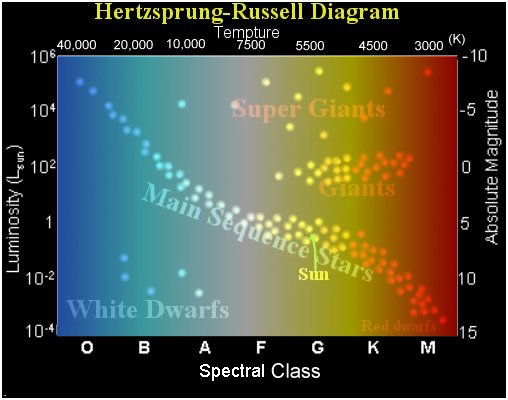

 |
 |
| Rm. A111: What is a Star? |
When you look at the night sky the most noticeable objects (other than the Moon) are stars. If you look at a star through a telescope it will look only brighter. You will never see a star as nothing more than a point of light, but you will be able to see fainter stars. The ability of a telescope will enable you to see star clusters, some of which look like jewels spilled out on black velvet.
Most stars are like our Sun, but those are not what most of the stars you see in the night are. Most of the stars you see are exceptionally bright stars that blaze across the heavens like beacons. Some of these stars are burning their fuel at a tremendous rate and will go out of a flash of glory. Others have swollen so big that they would easily fill more than the inner part of our Solar System. Antares is such a star. Antares is 326 light years away, further than most stars of similar brightness. Antares is a bit brighter than Alpha Centari at 4 light years away and a bit dimmer than Procyon at 10 light years away. If you compare Antares with most of the other stars in the area you should notice it is bright and has a reddish tint to its color. This is because Antares is a Red Super Giant star. It has neared the end of its life and swollen so large that its surface has cooled and glows only red hot. Stars glow at different colors depending on how hot they are. Stars put out all kinds of energy and light, and where the energy peaks shows the temperature of the stars surface. Stars are classified according to their temperature O for the hottest then B, A, F, G (our own Sun is here), K, and M for the coolest stars.

According to the stellar life cycle theory, stars will spend most of their life quietly converting Hydrogen to Helium at their core and those stars are called Main Sequence Stars. How much Hydrogen a star has (its mass) determines how quickly it converts Hydrogen to Helium and that determines how hot it is, its classification and how log it will live.
According to the same theory, the star Antares has converted all its Hydrogen at its core and is now converting some other element for its energy. This creates a hotter core and this greater energy pushes the surface further away (expands). As the surface expands it cools. So you have a hotter core with a cooler bloated surface. Some stars can bloat so much, that if they were sitting where our Sun is, the surface would be past Jupiter or maybe even past Saturn.
Stars come in many sizes and colors, depending on their mass (how much stuff they have) and their age.



· Brown Dwarfs - Brown Dwarfs are almost stars. They are in that area where they are too massive to be considered a planet and possibly not even orbit around another star. They are just small enough to avoid the process of converting Hydrogen to Helium. They glow from the heat of their contraction mostly in the infrared and would be seen as a very dim red star. They are about Jupiter size but more massive
· Red Dwarfs - Red Dwarfs are true stars down to 1/10 the mass of the Sun. They glow a dim red from the energy created from fusing hydrogen to helium. It is estimated that red dwarfs make up most of the population of the stars. These stars make up the M classification of stars. These stars burn for a very long time and it is guessed that they just stop converting hydrogen to helium and cool off.
· Mid Mass Stars - Mid Mass Stars are stars that are about the same mass as our Sun (up to three times to about half as massive). These stars will continue to burn till the core is carbon. As they age they will swell to become red giants, loose their outer envelope as a planetary nebula, and then die as a white dwarf.
· Massive & Super Massive Stars - Massive Stars are most of the stars you see when you look up in the night sky. They are bright beacons that stand out even at large distances. These stars burn bright throughout their lives and go out with a flash (supernova) that can be brighter than all the stars in the galaxy combined. These stars end their lives as Neutron Stars or Black Holes depending upon their Mass.
· Red Giants - Red Giants are old average size stars that have swollen to huge proportions (~50 - 100 million miles in diameter). This is close to the stars final gasp when it looses its outer envelope and becomes a planetary nebula.
· Red Super Giant - Red Super Giants are old massive stars that have swollen to such huge proportions that if they were sitting where our Sun is they would swallow up Jupiter and maybe even Saturn. These monsters are in the final stages before the star violently explodes as a super nova.
· Blue Giants - About the same as red giants except surface is hotter, and the star is not as bloated. The star will most certainly die as a supernova instead of becoming a white dwarf.
· White Dwarfs - White Dwarfs are the burned out remains of average stars. A star that has just died will have a white dwarf, which is the naked stellar core, surrounded by the blown off outer layers of the old star. The core (white dwarf) is intensely hot (+11,000 degrees) and shines brightest in the ultraviolet. This ultraviolet light causes the expanding shell of the blown off outer layers to glow brightly as a planetary nebula. The envelope eventually blows away in to deep space and the core, no longer burning, slowly cools. A white dwarf ends up around the size off the earth.
· Neutron Stars - Neutron Stars are the burned out remains of a more massive star. Like a white dwarf it is the exposed core of the exploded star. But the amount of matter left on the core is so great that the normal repulsion those atoms have, that keep them apart, is over come buy the weight. The electrons and atom nucleus crush together and become neutrons. So you end up with a core of neutrons. A neutron star ends up being a very round ball around the size of a city (~10 miles diameter).
· Black Hole - Black Holes are the remains of stars that were so massive, that when they stopped making energy through fusion, that there was no force strong enough to over come the gravity and stop the complete collapse into a black hole. The gravity is so strong that not even light can escape. The size of a Black Hole can only be mathematically guessed at being a single point infinitely small